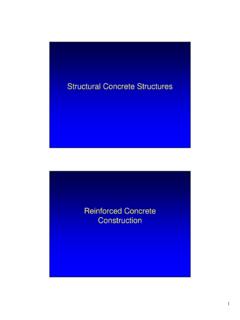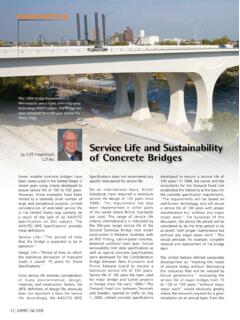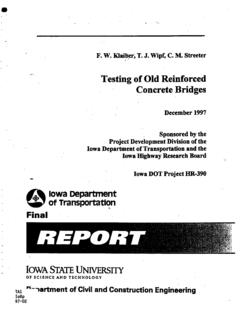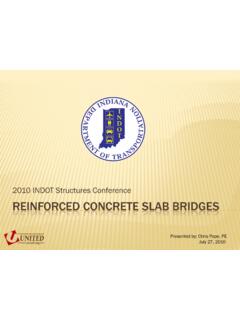Transcription of A SIMPLE METHOD FOR RATING OF REINFORCED …
1 A SIMPLE METHOD FOR RATING OF REINFORCED CONCRETESLAB BRIDGESWije Ariyaratne, (Eng), , Grad Dip Bus, FIE , bridge Engineering, bridge Section, RTAP arvez Shah, (Eng), Struct, Grad Dip Bus, MIE , bridge Evaluation and Assessment, bridge Section, RTAV ijay Kodakalla, (Civil), (Struct), Grad Dip IT, MIE Engineer, bridge Evaluation and Assessment, bridge Section, RTAABSTRACTT here are over 180 REINFORCED concrete slab bridges under the jurisdiction of the Roads andTraffic Authority of New South Wales (RTA). Of these bridges about 70 were built prior to1948 when the design loading was between 16 and 17 aim of the project is to develop a quick and a SIMPLE METHOD to determine the RATING ofthe REINFORCED concrete slab bridges. Yet this METHOD needed to be safe and be able to deliverrealistic paper discusses three different assessment methods used for a typical concrete slabbridge, which was earlier proof load tested by the RTA.
2 These methods are the NAASRA1976, Linear Grillage (LG) analysis and Effective Width METHOD (EWM). The resultsobtained from these methods are compared with the RATING obtained from the proof loadtesting of this Element Analysis (FEA) of a bridge will give RATING close to that obtained from a ProofLoad Test. However, this is time consuming and is therefore suitable for RATING of anindividual bridge . Of the three methods compared, the EWM has the advantage of being iseasy to apply, less time consuming, reliable and conservative and is therefore suitable for loadrating of a group or groups of REINFORCED concrete slab is therefore concluded that the EWM is a suitable METHOD for load RATING of a group orgroups of concrete slab Ariyaratne, Manager, bridge Engineering, bridge Section, RTA OperationsWije Ariyaratne is a graduate in Civil Engineering from the University of Ceylon and has aMasters degree in Structural Engineering from the University of NSW and a GraduateDiploma in Business from the Deakin to joining the Roads and Traffic Authority of NSW (RTA)
3 In 1972, he had five yearsexperience in the design and construction of maritime structures in Sri joining the RTA he has had wide experience in design, investigation, construction,contract administration, operations and evaluation and load assessment of 2000 he has been the Manager, bridge Engineering leading the bridge Section andproviding the RTA with input and high level advice necessary for the development ofstrategies for the effective and efficient operation and maintenance of the RTA $ B represents the RTA on AUSTROADS and Standards Australia committees. He is also avisiting lecturer at the University of Technology, Sydney and has fourteen technicalpublications to his Shah, Manager, bridge Evaluation and Assessment, bridge SectionParvez Shah is a graduate in Civil Engineering from Bangladesh and has a Master ofEngineering in Structural & Construction Management from Asian Institute of Technology,Thailand and a Graduate Diploma in Business & Technology Management from DeakinUniversity, was engaged by World Bank as a local consultant of Hazra International for InfrastructureMaster Plan for Bangladesh after graduation.
4 Since joining RTA he has had fourteen yearsexperience in bridge engineering. He was responsible for structural design for more than fortystructures including two Voided slab bridges at Yass Bypass, Viaduct on Homebush BayDrive, support structure for noise wall on Anzac bridge arterial. He had extensive experiencein instrumentation and load testing of different types of bridges. He has successfullyconducted load testing of forty-nine bridges in NSW for RTA, local councils and is the Manager, bridge Evaluation and Assessment Unit of the bridge Section since July2000 and he has published six technical papers for international and national Kodakalla, Project Engineer, bridge Evaluation and Assessment, bridge SectionVijay Kodakalla is a graduate in Civil Engineering and postgraduate in StructuralEngineering. He also holds a Graduate Diploma in Information Technology from theUniversity of Technology, Sydney.
5 He has more than 20 years of work experience in thedesign, design management, inspection and assessment of bridges. He was responsible for the design and design management of bridges on Expressway projectson the National Highways in India, funded by World Bank. He was associated in the design,design management of bridges in the infrastructure projects such as M2 Motorway in Sydney,Pacific Motorway and Melbourne City joining the Roads and Traffic Authority in 1998, he has been involved in the RATING ofvarious types bridges and assessment of routes for the movement of various types of heavyloads, Mass Limit Review of B-Doubles, B-Triples and has a published paper in the International Seminar on bridge Structures and Foundations organised by the Institution of bridge IntroductionThere are over 180 REINFORCED concrete slab bridges under the jurisdiction of the Roads andTraffic Authority of New South Wales (RTA).
6 Of these bridges about 70 were built prior to1948 when the design loading was between 16 and 17 RATING of the pre 1948 slab bridges using NAASRA 1976 METHOD is observed to be veryconservative when compared with any other aim of the project is to develop a quick and a SIMPLE METHOD to determine the RATING ofthe REINFORCED concrete slab bridges. Yet this METHOD needed to be safe and be able to deliverrealistic bridge selected for studyThe bridge over Mulyandry Creek is a five span REINFORCED concrete (RC) Slab bridge builtin 1940 with span and a carriageway width of between the kerbs and it carriestwo lanes of traffic. A photograph of the bridge is shown in Figure bridge was selected as it represents about twenty RC slab bridges in RTA road networkand it was proof load tested in CreekProof Load Testing over the BridgeFigure 1: Mulyandry Creek photosMaterial strengths:The concrete compressive strength ( concrete Class A ) f c = MPaThe yield strength of mild steel reinforcement is not given on the drawings but a value of fsy =230 MPa is assumed based on the code used at that LoadsThe loading considered in the analysis included self weight of the structure (DL),superimposed dead load (SDL) and live load of a general access vehicle semi-trailer ( ).
7 The axle loads and spacing for this vehicle are given in Figure has been used in the study, as it is the critical legal load on short to medium spanbridges. The live load factors are determined for based on ultimate limit state inaccordance with the Australian bridge Design Code (ABDC) 1996. t 3 m m m m 20 t 6 t is a six axle articulated vehicle with GVM 2. Semi-Trailer dynamic load allowance of 25% of the live load was used based on the first naturalfrequency of the structure. The worst live load case comprised of two trucks passing over thebridge critical longitudinal positions and axle locations are shown in Figure 3. Critical load position for maximum bending moment4. RATING EquationThe concept of RATING is based on ultimate limit state design principle that the assessedminimum capacity of the bridge must be greater than the assessed maximum load bending and shear has been considered for RC slab bridge and it has been determinedthat the critical mode of failure for this bridge is bending the RATING equation is: Mu > M + + LL M (1)Where = Capacity reduction factor = LL = Live Load Factor (> as per ABDC 1996).
8 Mu = Ultimate moment capacity of the cross section per metre = Ultimate moment due to dead Ultimate moment due to superimposed dead TridemSpan = used for calculating properties750 Longitudinal edge750 Transverse610 Longitudinal - Internal457M = moment due to live load including dynamic load allowance( ) and lane modification factor for two lanes loaded( )Therefore LL =( Mu )/ M (2)5. ANALYTICAL RATING METHODSThe bridge was analysed using the following analytical methods. The methods are Empirical METHOD in NAASRA (1976) bridge Design CodeThe NAASRA BDC Art. (b) specifies the following formula to evaluate the designbending moment per width, when the main reinforcement is parallel to KNm(3)WhereM = the design longitudinal moment per design lane determined by suitableanalysis using appropriate standard Vehicle = + (max )S = span (m) Grillage METHOD of analysisThe grillage analysis is performed using Microstran V7.
9 The deck slab is modelled with tenlongitudinal beams and two edge beams. Transversely the deck has been modelled with ninebeams and this is considered appropriate to the span to width ratio of The effectivewidths for calculation of inertias are shown in Figure 4. Grillage ModelLongitudinalbeamsTransverse beamsThe live load is applied on the grillage using the moving load generator for two loadcases, one from the kerb and the other of symmetrical loading as shown in Figure Wheel LoadFigure 5. Critical Load CasesThe maximum bending moment obtained from the above analysis is then calculated per metrewidth of the slab for comparison with the other methods. The values are tabulated in Table Effective Width METHOD (EWM) of Analysis:The analysis of moments and shears under concentrated loads is a statically indeterminateproblem and to obtain an accurate solution for support conditions in practice is very timeconsuming and complex.
10 A semi-empirical METHOD can be used when a slab is supported ontwo opposite edges a concentrated load acts on the slab, the slab deforms like a saucer. Under a verticalload a slab will have curvature in the direction of the span as well as at right angles to it. Thusbending moments in the slab are created in the direction of the span and normal to , EWM considers the load distribution on the strip below the load and either sideof it. It is therefore assumed that the load is supported by a certain width of the slab, known asthe effective width. The details of the effective width of the slab are shown in Figure the effective width is known, then the moments in the direction of the span can becalculated using the line beam Load CaseP P P PSymmetrical Load Case1800180013021200600254254 P P P P25425418006006001800254254 Figure 6 Effective width of slabDispersion across the deck:For a single concentrated load the effective width (Bef) is given byBef = K x ( 1- x/L ) + bw(4)Where x is the distance of the centre of gravity of load from the nearer support.











